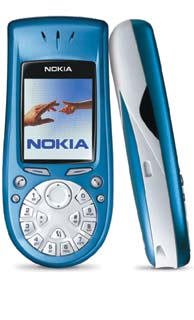| Review of the Nokia 3650 |
| Review of the Nokia 3650 |
 |
The 3650 is without a doubt a gadget lovers dream. It has loads of features that should get the gadget fanatic drooling with anticipation. And best of all, it isnít just a pipe dream, because the phone really lives up to its billing. Last Updated: 03-Apr-2003
|
Before reading this review, please read Some Thoughts on Phone Reviewing.
Thanks to Jeff Setton for lending me the 3650.
General
Before we get started however, I should note that the 3650 is for those with deep pockets. Not only will the phone set you back by $600 to $700 (Canadian), but youíll absolutely have to get an unlimited GPRS plan to support what this phone does. Yes, you can use many of the phoneís features without GPRS, but youíre going to feel totally crippled without it.
Youíll also find that you wonít be able to get away with low-usage plans, since the volume of data that can be transferred using this phone is phenomenal. So, count on spending at least $50 per month above and beyond whatever you presently spend on voice service. If you can justify the price though, you are in for a treat.
In terms of size, the 3650 is a bit on the bulky side, at least compared to phone-only devices. However, when compared to full-blown PDA-phones, the unit is actually quite small, and relatively light. The phone tips the scales at 130 grams, which is just less than 5 ounces. Thatís no heavier than the old Nokia 5190/6190 with the standard BLS-2 battery.
The shape and styling of the phone are a bit odd however. Instead of proving a standard grid of numeric keys, the phone provides a set of numbers that are arranged around the circumference of a circle. This is rather reminiscent of an old dial phone. This odd layout will take some getting used to, but I assume that youíll eventually adjust. The feel of the phone is okay, but Iíve certainly felt more comfortable designs.
The menu system has nothing in common with a typical Nokia phone, since unlike most of Nokiaís models this one is based on the Symbian operating system. Quite a few phone manufacturers have signed on to use this particular Smartphone OS, which means youíll be seeing it more and more often in the future (assuming Microsoft doesnít succeed in its bid to make a version Windows CE the standard OS for future Smartphones).
Because Symbian is a computer-like operating system, much of the phoneís functionality is also rather computer-like. Everything the phone does is treated like an application, and icons for launching applications can be moved into various folders on the phoneís menu. Once an application is launched, others can be launched simultaneously, and you can switch between apps at will.
All of this is displayed to you on color display measuring 206 pixels in height by 176 pixels in width that supports 4096 colors. It is a bit disappointing that Nokia didnít go with a 65,000 color display, thus getting around the need for pallets, but in my testing of the phone I didnít find this to be a particularly noticeable problem.
Features are virtually endless, and itís this facet of the phone that should appeal the most to gadget lovers. Included are all of the standard features one comes to expect from Nokia phones, such as Profiles, calendar, to-do list, and excellent phonebook. But, along with them is a bevy of advanced features that mean you could spend an entire day playing with this thing without ever making a single phone call.
Up first is the built-in camera that
will take 640 x 480 digital photographs. Iíve included one at the bottom of
this review. These pictures can be stored in the approximately 3.5 MB of
internal RAM, or onto an optional memory card of up to 512 MB
in size. In fact, virtually anything you can store in the phone memory can also
be stored in the removable memory card.
The
camera can also be used to take smaller thumbnail
pictures that can be attached to phonebook entries. These small images are
displayed when you receive a call from the person in question. However, I have a
gripe with how this is done, since only a tiny
little image is actually shown when the call comes in, rather than a
full-screen image.
Not
only does the phone take still images, it can also record mini-movies of up to
10 to 13 seconds in length. These movies and photographs can then be sent to
others using GPRS, either directly to another compatible Smartphone, or to a PC
using an e-mail attachment. This is where youíre going to need that unlimited
GPRS package, since youíll probably end up sending quite a few pictures and
movies.
It
is possible to transmit this data to another phone or to a PC using IR or
Bluetooth, thus avoiding any GPRS charges. You can download free software from Nokia
that allows you to manage the information inside of the phone and transfer it to
or from the computer using IR or Bluetooth.
Because
the phone has IR and Bluetooth, it is well suited as a tethered data provider as
well. If you also need to the surf the web on a full-blown laptop computer, you
can easily accomplish this. You already have the unlimited GPRS connection (I
assume), and so you donít have to worry about how quickly web surfing can eat
up megabytes.
One
interesting note about the Bluetooth is that the 3650 would not
support the Ericsson HBH-15 Bluetooth
headset. However, the same headset works fine on my Nokia 6310i.
One
of the built-in applications of the phone is something called RealOne Player. Itís a micro version of the well known
computer-based RealPlayer. This
application can not only play various video and audio formats from files stored
in your phone, it can also play streaming video and audio files from the
Internet.
Another
very useful built-in application is e-mail. You can use it send and receive
e-mail from any IMAP or POP3 server, and you can even open attachments in those
messages (so long as the phone knows how to deal with the file type). This makes
it possible for others to e-mail you pictures, movies, and sound files directly
from their home computers.
So
that you can upload your own applications, the phone supports J2ME (Java). I suspect that there will be quite a few applications
becoming available over the next year or so, especially given the power of this
phone. NOTE: Iím not 100% sure of this, but it will probably also accept
programs written for the native Symbian
OS.
The 3650 itself supports XHTML, but it will not natively display an HTML page. However, companies such a Reqwireless sell proper HTML browsers that load into the 3650 as a Java application.
RF Performance and Audio Quality
But
what about audio quality and RF
performance? Iíve sampled far too many Smartphones that sound like crap,
or have poor RF performance. Those days are finally over, because the 3650
has excellent audio quality and RF performance. During a series of tests
performed in weak signal areas, the 3650
proved to be the equal of the 6310i.
If youíve read my review of that phone, youíd know I think very highly of its overall performance.
Sound
quality is very similar to the 6310i,
though it lacks a bit in the low-end that gives the 6310i
a slightly richer sound on some types of voices. To compensate, the 3650
has less background hiss than the 6310i,
though the amount of hiss on my 6310i
wasnít that bad to begin with, and was only detectable at full volume in a
quiet room.
The
3650 isnít quite as loud as the 6310i
however, and even though it too supports the volume-boost
feature, it isnít quite as obvious as it is on the 6310i.
That isnít to say that the 3650
isnít loud enough. It has plenty of earpiece volume to put it ahead of many
other phones on the market. It also has remarkably loud ringers, though you only
get the benefit of really loud
ringtones that are not polyphonic.
So
where does that leave us? We have a truly great performing and great sound phone
mated to a very powerful set of gee-whiz features that should have even the most
hardened gadget nuts amused for ages. In other words, itís probably one of the
most exciting and satisfying cell phones on the market today. If you can justify
the price of the hardware and the price of its upkeep, and you donít mind the
rather weird keypad, the 3650 is
definitely the phone for you.
As for myself, Iím not buying one, at least not for now. This isnít because I wouldnít love it if I had one, but Iím just not sure I could justify the upkeep. You should give this very serious consideration yourself, since the phone is going to turn you into a heavy GPRS user whether you like it or not. For that reason alone, Fido and Rogers should be scooping these things up by the boatload and pushing them out the door just as hard as they can.
Finally, here is a sample of a photograph taken with the 3650. It's of yours truly, outside the house of Jeff Setton, the phone's owner:
